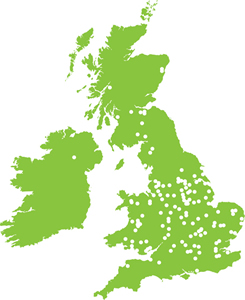Glenkerie Wind Farm |
|
Whole Project Award
Project Team:
Client: Infinis
Design & Construction: I & H Brown
Turbine Supplier/Installer: Vestas
The Project
Infinis’ 22MW Glenkerie wind farm is located 5km north-west of Tweedsmuir, near Biggar on a hill farm predominantly used for sheep-grazing, rough pasture and heather moorland. Initial feasibility studies identified the site as well elevated, windy, and remote from residential properties limiting its view from the surrounding area.
The planning application for the wind farm was submitted in December 2007 with consent received in September 2008. Construction of the wind farm, involving 11 wind turbines, 9km of access roads and 43km of new grid infrastructure is now nearing completion and ready for commissioning.
Glenkerie is the first of Infinis’ renewable energy projects to be assessed against the CEEQUAL criteria, with 300MW at various stages of development benefiting from the lessons learnt in construction and a further 700MW in feasibility to benefit from the client and design review.
A key reason for the development of renewable sources of energy is to reduce the volume of greenhouse gases and other pollutants that are produced by generating electricity from conventional fossil fuel sources. The proposed Glenkerie wind farm is predicted to prevent the emission of up to 66,000 tonnes of carbon dioxide per year1, as well as preventing the emissions of sulphur dioxide and nitrogen oxides. The wind farm is expected to generate the equivalent of the average annual electricity use of around 16,000 households, based on an average capacity factor of 36.8%2.
Infinis renewable energy locations across the UK
Environmental impact assessment
A full independent Environmental Impact Assessment (EIA) was conducted on the site, which identified and assessed the impacts the development would have on the built, natural and human environment. Once the impacts had been identified Infinis were able to propose control measures to eliminate or minimise these impacts.
The EIA explored the following issues: landscape and visual, traffic, access and highways, ecology, ornithology, cultural heritage, hydrogeology, telecommunications, aircraft safety and radar, access, recreation and tourism, socio-economics and noise. Some control measures identified from the EIA included the engagement of an Ecological Clerk of Works (ECoW), traffic restrictions during certain environmental windows, bird breeding mitigation works implemented prior to works commencing, reptile management requirements throughout the works and imposing lighting restrictions within the construction compound area to minimise the impact on bats. A plastic fox was even placed on top of turf stored at the side of the road to dissuade birds from the road line. Details of the assessments undertaken were submitted alongside the planning application which identified how the final project design and construction would reduce any potential negative environmental impacts.
 |
Ecology
Two watercourses, Kingledores Burn and Holms Water are situated to the south and north of the site and are designated Special Area of Conservation sites for Atlantic salmon, lampreys and otter. During the construction of the wind farm, measures were put in place to avoid any impact on them. These included limiting construction to certain periods of the year and the construction of a number of bridges in a sensitive manner to protect and enhance the existing environment.
Effects on neighbours
Consultation with the local community was undertaken to provide information about the project and to listen to feedback from the local community. The wind farm layout was designed to minimise the visual impact of the scheme. This included the use of shortened turbine towers in some locations. There were regular updates provided through the Community Council newsletters and a community trust fund is being established for local people to benefit from. Projects such as sponsorship of the local summer fete and support to the community buy-out of the currently derelict local 17th Century pub, the Crook Inn (this is one of the oldest pubs in Scotland and was frequented by Robert Burns).
Project design and construction challenges
There were a number of design and construction challenges along the way not least the designing of a site that would be constructed safely and sympathetically on the side of a hill 450m above the surrounding glen. A drainage system had to be designed and installed to control the flow of water running down the steep slopes and prevent environmental damage to the sensitive watercourse below. Preventing pollution of an important tributary to the nationally renowned River Tweed whilst carrying out major earthworks, building bridges and roads was a fundamental project challenge.
1Glenkerie Wind Farm Environmental Statement Report December 2007.
2
This calculation is based on the predicted long-term average capacity factor of 36.8% for Glenkerie wind farm and an average GB household electricity consumption in 2009 of 4,423kWh (taken from the Sub-National Electricity Consumption Data 2009 published by DECC) which leads to a calculation of the equivalent electricity consumption of 16,000 households (rounded down to the nearest 500 households). It should be noted that the equivalent household electricity consumption calculated will vary depending on the actual average wind speeds in any year and the actual household electricity consumption for the same year.

